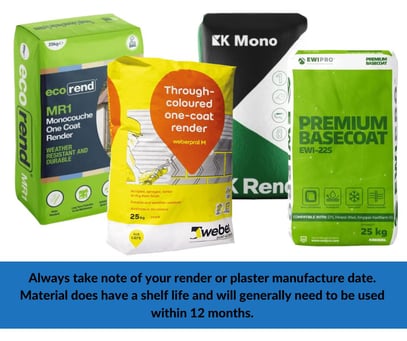If you store your materials incorrectly, you may find yourself with problems before you even get started on your plastering or rendering job. Moisture is the enemy and will damage your material causing lumping and partial setting. The quality of your plaster or render will then be compromised with problems of quick set or early stiffening. The issues may mean that a pallet of product is completely unusable and as well as wasting money, may also slow down your job. Find out more about how the weather can affect your render or plaster here >

The Problem with Storing Plaster and Render
Pre-bagged render and plaster is mixed with water in order to create a pumpable/sprayable consistency. The powdered material reacts with the water to achieve that creamy mix which can be applied to your walls. However, if moisture/damp/water/condensation unintentionally comes into contact with your product before the job begins this will cause problems. You should protect your material from
- Contact with rain, snow, frost and splashing water
- Direct contact with wet or damp surfaces
- Absorption due to high humidity levels
- Condensation which often occurs when waterproof plastic covering is used as moisture gathers during the warmth of the day which then condenses when it is cooler overnight.
How can I protect my Plaster or Render?

Ideally you should store your material inside or under cover in some form to ensure it remains dry. We advise to
- Stack on planks or platforms away from possible damp floors/walls
- Ensure the floor is clean and dry
- Keep the material in it’s packing until use
- Always protect bottom bags with vapour retarder
- Ensure you protect the bags from excessive sunlight/UV rays
If storage is limited and you need to store outdoors, take note of the following guidance:
- Stack off the ground supported on a level platform
- Protect fully from the weather/moisture by placing a sheet of plastic/vapour resistant material on the material platform
- Ensure your plastic sheet extends 2ft beyond the base edge
- After stacking 1-2 layers fold the plastic in to overlap the bags and continue stacking (the weight of the bags will hold the sheets in place)
- Cover the completed pile with a protective sheet/waterproof tarpaulin
Condensation can be a big problem for render/plaster. Condensation occurs when warm moist air comes into contact with cool surfaces. This problem generally comes into play the longer you store your material with the temperature increasing in the daytime and then dropping and cooling at night. If you are storing your material for over 12 hours only use waterproof tarpaulins as they allow the contents to breath enabling condensed trapped moisture to escape and vaporise, plastics won’t allow this.
Ideally, get your material delivered as close to your project start day as possible to avoid any storage issues. Please also be aware that render and plaster does have a shelf life and the manufacture date will be marked on the bags. Whilst it varies by brand of render/plaster, generally render should be used within 12 months from the batch date.
